Low-Order Reactor-Network-Based Prediction of Pollutant Emissions Applied to FLOX® Combustion
Abstract
:1. Introduction
2. Laboratory Scale Test-Case Combustor
3. Computational Combustion Dynamics
3.1. Numerical Setup
3.2. Validation with Experiments
4. Reaction Network Modeling
4.1. Setup and Modeling Procedure
4.2. Results and Discussion
5. Conclusions
Funding
Institutional Review Board Statement
Informed Consent Statement
Data Availability Statement
Acknowledgments
Conflicts of Interest
Abbreviations
| CFD | Computational fluid dynamics |
| DES | Detached eddy simulation |
| DLR | German Aerospace Center |
| EDC | Eddy dissipation concept |
| EDM | Eddy dissipation model |
| ERN | Emission reactor network |
| FLOX® | Flameless oxidation |
| FSD | Flame surface density |
| LBO | Lean blow-out |
| LES | Large eddy simulation |
| MGT | Micro gas turbine |
| MILD | Moderate or intense low oxygen dilution |
| MTT | Micro Turbine Technology b.v. |
| PFR | Plug flow reactor |
| PIV | Particle image velocimetry |
| PSR | Perfectly stirred reactor |
| RANS | Reynolds-averaged Navier–Stokes |
| UHC | Unburned hydrocarbon |
References
- Bundesministerium fuer Umwelt, N.u.R. TA Luft. 2021. Available online: http://www.verwaltungsvorschriften-im-internet.de/bsvwvbund_18082021_IGI25025005.htm (accessed on 1 January 2022).
- Nguyen, T. Improved Chemical Reactor Network Application for Predicting the Emission of Nitrogen Oxides in a Lean Premixed Gas Turbine Combustor. Combust. Explos. Shock Waves 2019, 55, 267–273. [Google Scholar] [CrossRef]
- Zeldovich, Y. Oxidation of Nitrogen in Combustion and Explosions. In Selected Works of Yakov Borisovich Zeldovich, Volume I; Princeton University Press: Princeton, NJ, USA, 1992. [Google Scholar] [CrossRef]
- Fenimore, C. Formation of nitric oxide in premixed hydrocarbon flames. Symp. (Int.) Combust. 1971, 13, 373–380. [Google Scholar] [CrossRef]
- Malte, P.; Pratt, D. Measurement of atomic oxygen and nitrogen oxides in jet-stirred combustion. Symp. (Int.) Combust. 1975, 15, 1061–1070. [Google Scholar] [CrossRef]
- Gruhlke, P.; Beck, C.; Janus, B.; Kempf, A. LES Analysis of CO Emissions from a High Pressure Siemens Gas Turbine Prototype Combustor at Part Load. Energies 2020, 13, 5751. [Google Scholar] [CrossRef]
- Lieuwen, T.; Yang, V. Gas Turbine Emissions; Cambridge University Press: Cambridge, UK, 2013. [Google Scholar] [CrossRef]
- Lovett, J.; Abuaf, N. Emissions and Stability Characteristics of Flameholders for Lean-Premixed Combustion. In ASME Turbo Expo; ASME: New York, NY, USA, 1992; 92-GT-120, V003T06A017. [Google Scholar] [CrossRef] [Green Version]
- Nguyen, Q.; Edgar, B.; Dibble, R.; Gulati, A. Experimental and Numerical comparison of extractive and in situ laser measurements of non-equilibrium carbon monoxide in lean-premixed natural gas combustion. Combust. Flame 1995, 100, 395–406. [Google Scholar] [CrossRef]
- Howard, J.; Williams, G.; Fine, D. Kinetics of carbon monoxide oxidation in postflame gases. Symp. (Int.) Combust. 1973, 14, 975–986. [Google Scholar] [CrossRef]
- Bulat, G.; Jones, W.; Marquis, A. NO and CO formation in an industrial gas-turbine combustion chamber using LES with the Eulerian sub-grid PDF method. Combust. Flame 2014, 161, 1804–1825. [Google Scholar] [CrossRef]
- Jaravel, T.; Riber, E.; Cuenot, B.; Bulat, G. Large Eddy Simulation of an industrial gas turbine combustor using reduced chemistry with accurate pollutant prediction. Proc. Combust. Inst. 2017, 36, 3817–3825. [Google Scholar] [CrossRef]
- Wegner, B.; Gruschka, U.; Krebs, W.; Egorov, Y.; Forkel, H.; Ferreira, J.; Aschmoneit, K. CFD Prediction of Partload CO Emissions Using a Two-Timescale Combustion Model. J. Eng. Gas Turbines Power 2011, 133, 071502. [Google Scholar] [CrossRef]
- Klarmann, N.; Zoller, B.; Sattelmayer, T. Numerical modeling of CO-emissions for gas turbine combustors operating at part-load conditions. J. Glob. Power Propuls. Soc. 2018, 2, 376–387. [Google Scholar] [CrossRef]
- Maas, U.; Pope, S. Simplifying chemical kinetics: Intrinsic low-dimensional manifolds in composition space. Combust. Flame 1992, 88, 239–264. [Google Scholar] [CrossRef]
- Bhargava, A.; Kendrick, D.; Colket, M.; Sowa, W.; Casleton, K.; Maloney, D. Pressure Effect on NOx and CO Emissions in Industrial Gas Turbines. In ASME Turbo Expo; American Society of Mechanical Engineers: New York, NY, USA, 2000. [Google Scholar] [CrossRef]
- Falcitelli, M.; Pasini, S.; Rossi, N.; Tognotti, L. CFD+reactor network analysis: An integrated methodology for the modeling and optimisation of industrial systems for energy saving and pollution reduction. Appl. Therm. Eng. 2002, 22, 971–979. [Google Scholar] [CrossRef]
- Falcitelli, M.; Pasini, S.; Tognotti, L. Modelling practical combustion systems and predicting NOx emissions with an integrated CFD based approach. Comput. Chem. Eng. 2002, 26, 1171–1183. [Google Scholar] [CrossRef]
- Falcitelli, M.; Tognotti, L.; Pasini, S. An algorithm for extracting chemical reactor network models from cfd simulation of industrial combustion systems. Combust. Sci. Technol. 2002, 174, 27–42. [Google Scholar] [CrossRef]
- Mohamed, H.; Ticha, H.; Mohamed, S. Simulation of pollutant emissions from a gas-turbine combustor. Combust. Sci. Technol. 2004, 176, 819–834. [Google Scholar] [CrossRef]
- Novosselov, I.; Malte, P.; Yuan, S.; Srinivasan, R.; Lee, Y. Chemical Reactor Network Application to Emissions Prediction for Industial DLE Gas Turbine. In ASME Turbo Expo; American Society of Mechanical Engineers: New York, NY, USA, 2006; GT2006-90282. [Google Scholar] [CrossRef]
- Russo, C.; Mori, G.; Anisimov, V.; Parente, J. Micro Gas Turbine Combustor Emissions Evaluation Using the Chemical Reactor Modelling Approach. In ASME Turbo Expo; American Society of Mechanical Engineers: New York, NY, USA, 2007; GT2007-27687. [Google Scholar] [CrossRef]
- Benedetto, D.; Pasini, S.; Falcitelli, M.; La Marca, C.; Tognotti, L. NOx Emission Prediction from 3-D Complete Modelling to Reactor Network Analysis. Combust. Sci. Technol. 2008, 153, 279–294. [Google Scholar] [CrossRef]
- Fichet, V.; Kanniche, M.; Plion, P.; Gicquel, O. A reactor network model for predicting NOx emissions in gas turbines. Fuel 2010, 89, 2202–2210. [Google Scholar] [CrossRef]
- Lee, D.; Park, J.; Jin, J.; Lee, M. A simulation for prediction of nitrogen oxide emissions in lean premixed combustor. J. Mech. Sci. Technol. 2011, 25, 1871–1878. [Google Scholar] [CrossRef]
- Lyra, S.; Cant, R. Analysis of high pressure premixed flames using Equivalent Reactor Networks for predicting NOx emissions. Fuel 2013, 107, 261–268. [Google Scholar] [CrossRef]
- De Toni, A.; Hayashi, T.; Schneider, P. A reactor network model for predicting NOx emissions in an industrial natural gas burner. J. Braz. Soc. Mech. Sci. Eng. 2013, 35, 199–206. [Google Scholar] [CrossRef]
- Colorado, A.; McDonell, V. Reactor Network Analysis to asses fuel composition effects on NOx emissions from a recuperated gas turbine. In ASME Turbo Expo; American Society of Mechanical Engineers: New York, NY, USA, 2014; GT2014-26361. [Google Scholar]
- Nguyen, T. Chemical reactor network application to predict the emission of nitrogen oxides in an industrial combustion chamber. Combust. Explos. Shock Waves 2017, 53, 406–410. [Google Scholar] [CrossRef]
- Nguyen, T.; Kim, S.; Park, J.; Jung, S.; Kim, S. CFD-CRN validation study for NOx emission prediction in lean premixed gas turbine combustor. J. Mech. Sci. Technol. 2017, 31, 4933–4942. [Google Scholar] [CrossRef]
- Innocenti, A.; Andreini, A.; Bertini, D.; Facchini, B.; Motta, M. Turbulent flow-field effects in a hybrid CFD-CRN model for the prediction of NOx and CO emissions in aero-engine combustors. Fuel 2018, 215, 853–864. [Google Scholar] [CrossRef] [Green Version]
- Kaluri, A.; Malte, P.; Novosselov, I. Real-time prediction of lean blowout using chemical reactor network. Fuel 2018, 234, 797–808. [Google Scholar] [CrossRef] [Green Version]
- Gupta, S.; Malte, P.; Brunton, S.; Novosselov, I. Prevention of lean flame blowout using a predictive chemical reactor network control. Fuel 2019, 236, 583–588. [Google Scholar] [CrossRef]
- Perpignan, A.; Sampat, R.; Gangoli, R. Modeling Pollutant Emissions of Flameless Combustion With a Joint CFD and Chemical Reactor Network Approach. Front. Mech. Eng 2019, 5, 63. [Google Scholar] [CrossRef]
- Zhang, Q.; Hai, H.; Li, C.; Wang, Y.; Zhang, P.; Wang, X. Predictions of NOx and CO emissionsfrom a low-emission concentric stagedcombustor for civil aeroengines. J. Aerosp. Eng. 2020, 234, 1075–1091. [Google Scholar] [CrossRef]
- Wünning, J.; Wünning, J. Flameless oxidation to reduce thermal NO-formation. Prog. Energy Combust. Sci. 1997, 23, 81–94. [Google Scholar] [CrossRef]
- Cavaliere, A.; Joannon, M. Mild Combustion. Prog. Energy Combust. Sci. 2004, 30, 329–366. [Google Scholar] [CrossRef]
- Lückerath, R.; Meier, W.; Aigner, M. FLOX® Combustion at High Pressure With Different Fuel Compositions. J. Eng. Gas Turbines Power 2008, 130, 011505. [Google Scholar] [CrossRef]
- Flamme, M. Low NOx Combustion Technologies for High Temperature Applications. Energy Convers. Manag. 2001, 42, 1919–1935. [Google Scholar] [CrossRef]
- Flamme, M. New combustion systems for gas turbines (NGT). Appl. Therm. Eng. 2004, 24, 1551–1559. [Google Scholar] [CrossRef]
- Lammel, O.; Stöhr, M.; Kutne, P.; Dem, C.; Meier, W.; Aigner, M. Experimental Analysis of Confined Jet Flames by Laser Measurement Techniques. In ASME Turbo Expo; American Society of Mechanical Engineers: New York, NY, USA, 2011; GT2011-45111. [Google Scholar]
- Seliger-Ost, H. Entwicklung eines FLOX-Basierten Brennersystems Für eine Rekuperierte Mikrogasturbine im Kleinen Leistungsbereich. Ph.D. Thesis, Universität Stuttgart, Stuttgart, Germany, 2019. [Google Scholar]
- Seliger-Ost, H.; Kutne, P.; Zanger, J.; Aigner, M. Experimental Investigation of the Impact of Biogas on a 3 kW Micro Gas Turbine FLOX-based Combustor. In ASME Turbo Expo 2020: Power for Land, Sea and Air; American Society of Mechanical Engineers: New York, NY, USA, 2020; GT2020-15556. [Google Scholar]
- Seliger-Ost, H.; Kutne, P.; Zanger, J.; Aigner, M. Experimental Investigation of the Impact of Biogas on a 3 kW Micro Gas Turbine FLOX-Based Combustor. J. Eng. Gas Turbines Power 2021, 143, 081020. [Google Scholar] [CrossRef]
- Seliger, H.; Stöhr, M.; Yin, Z.; Huber, A.; Aigner, M. Experimental and Numerical Analyses of a FLOX-based Combustor for a 3 kW Micro Gas Turbine under Atmospheric Conditions. In ASME Turbo Expo 2017: Power for Land, Sea and Air; American Society of Mechanical Engineers: New York, NY, USA, 2017; GT2017-63317. [Google Scholar]
- Cirigliano, D.; Grimm, F.; Kutne, P.; Aigner, M. Thermo-Structural Analysis of a Micro Gas Turbine Jet- and Recirculation- Stabilized Combustion Chamber. In ASME Turbo Expo 2020: Power for Land, Sea and Air; American Society of Mechanical Engineers: New York, NY, USA, 2020; GT2020-14561. [Google Scholar]
- Ansys Inc. ANSYS Fluent Theory Guide; Release 2020R1; Ansys. Inc.: Canonsburg, PA, USA, 2020. [Google Scholar]
- Li, J.; Zhao, Z.; Kazakov, A.; Dryer, F.L. An updated comprehensive kinetic model of hydrogen combustion. Int. J. Chem. Kinet. 2004, 36, 566–575. [Google Scholar] [CrossRef]
- Grimm, F.; Lingstaedt, T.; Kutne, P.; Aigner, M. Numerical and Experimental Study of a Jet-and-Recirculation Stabilized Low Calorific Combustor for a Hybrid Power Plant. Energies 2021, 14, 537. [Google Scholar] [CrossRef]



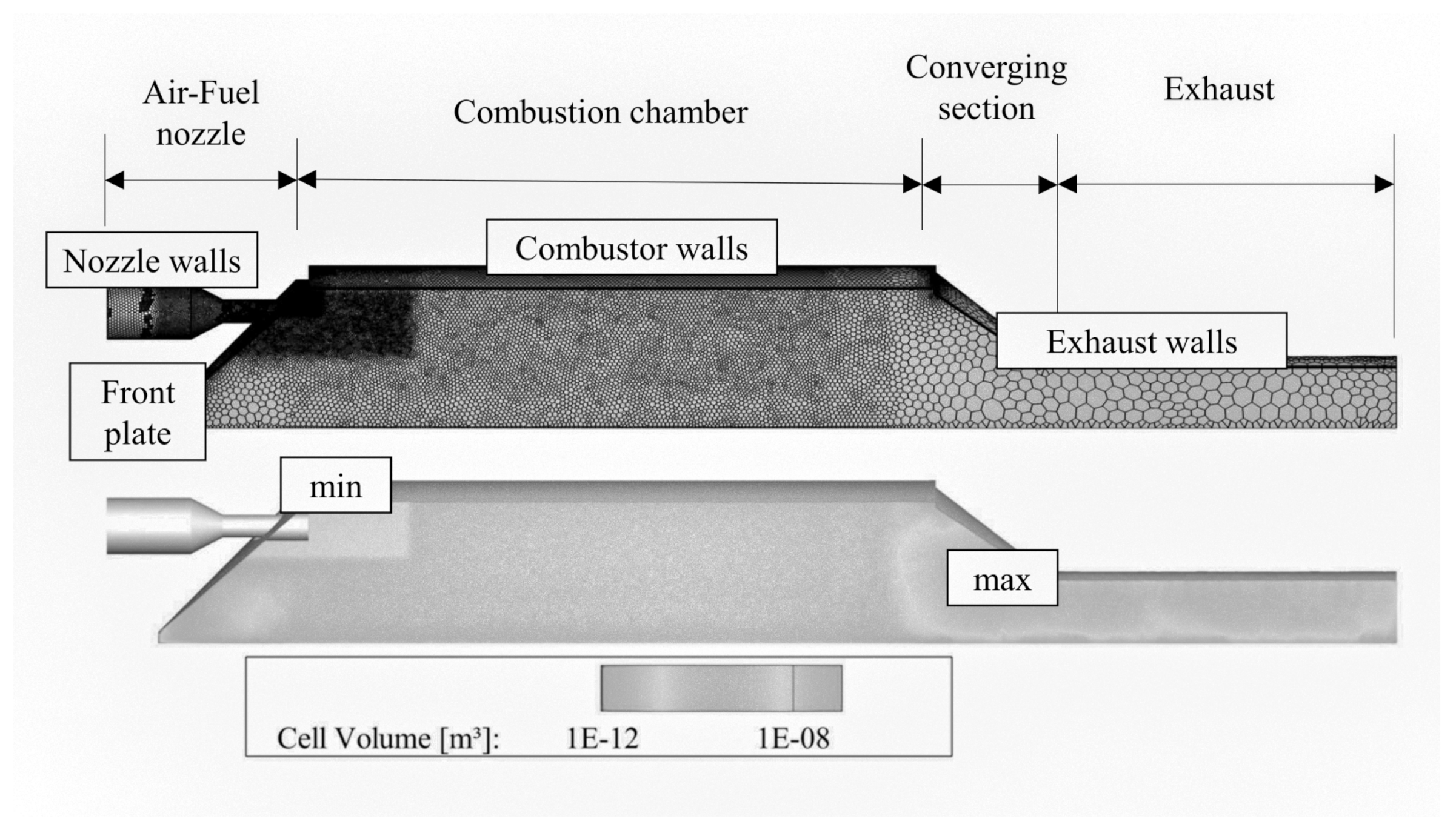

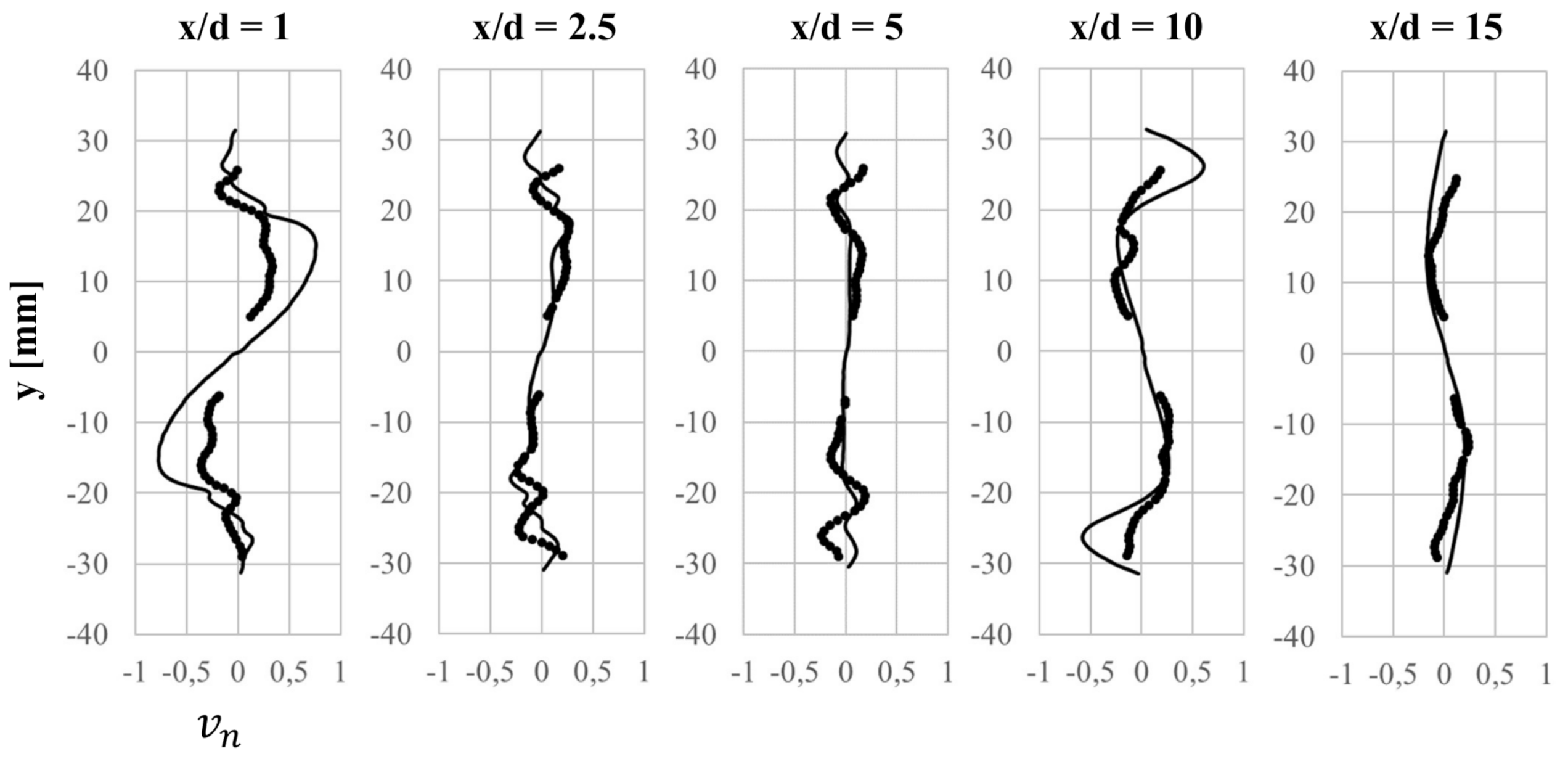


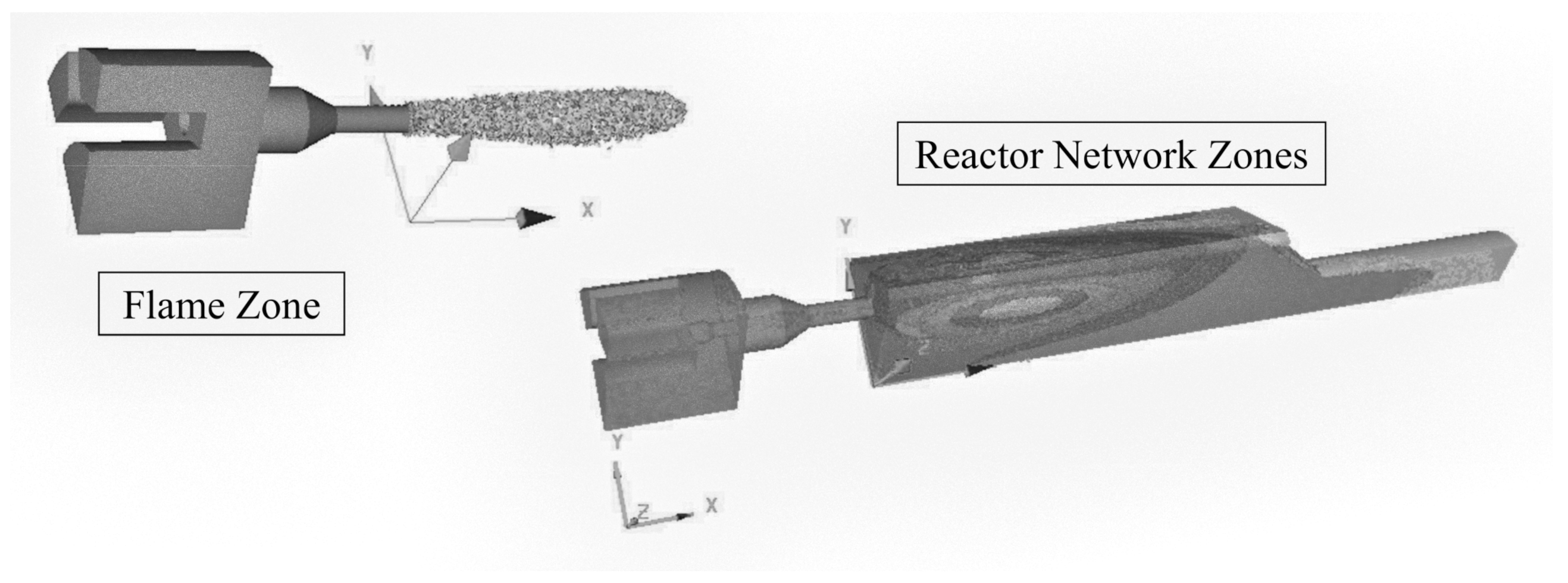

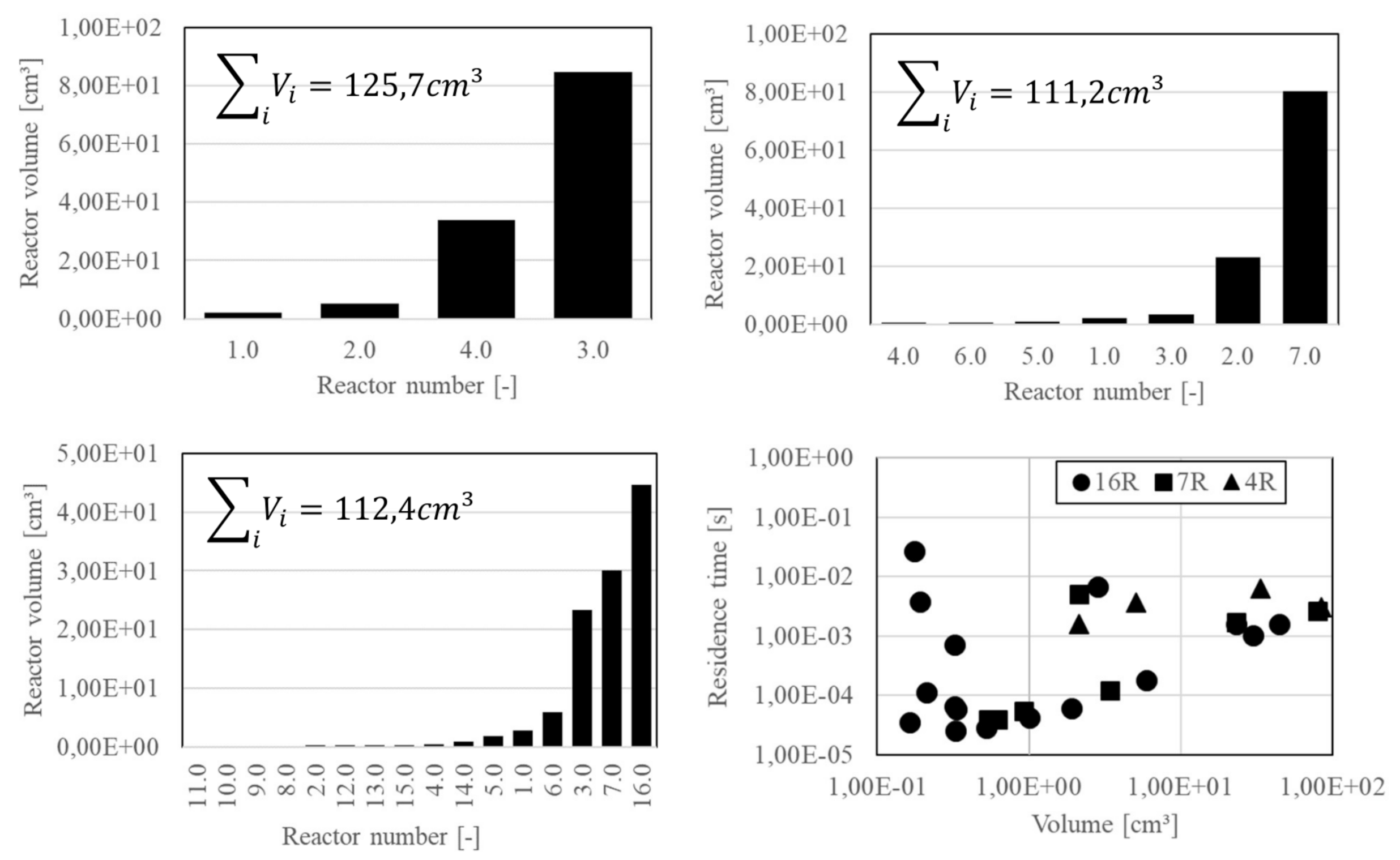
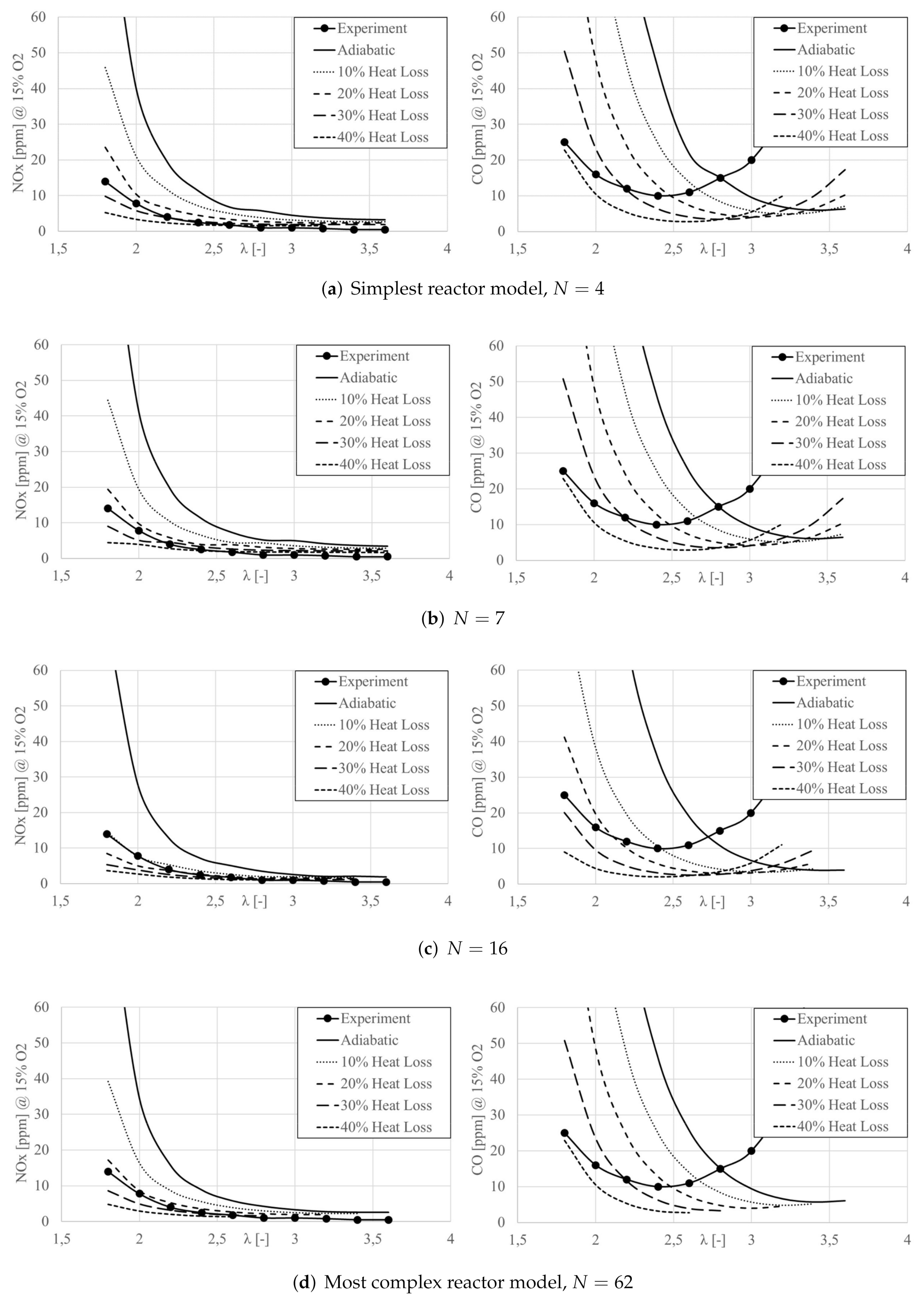
| Source | Year | C » E | C + E | E | Application |
|---|---|---|---|---|---|
| Bhargava et al. [16] | 2000 | x | Single-nozzle experiments and numerical modeling, study of pressure effects | ||
| Falcitelli et al. [17] | 2002 | x | NOx prediction in industrial energy combustion systems | ||
| Falcitelli et al. [18] | 2002 | x | NOx prediction in industrial furnaces, NOx reduction techniques | ||
| Falcitelli et al. [19] | 2002 | x | Methodical assessment of ERN pollutant prediction from CFD | ||
| Mohamed et al. [20] | 2004 | x | NOx, UHC, and CO for gas turbine combustion (model only) | ||
| Novosselov et al. [21] | 2006 | x | NOx and CO in a swirl-stabilized burner | ||
| Russo et al. [22] | 2007 | x | NOx and CO in a recuperated micro gas turbine | ||
| Benedetto et al. [23] | 2008 | x | Industrial furnace facilities | ||
| Fichet et al. [24] | 2010 | x | NOx emissions in a staged gas turbine combustor | ||
| Lee et al. [25] | 2011 | x | NOx emissions in a simplified combustor, GE7FA gas turbine | ||
| Lyra and Cant [26] | 2013 | x | NOx emissions in a high-pressure nozzle test case | ||
| De Toni et al. [27] | 2013 | x | NOx emissions in a BERL 300 kW furnace combustor | ||
| Colorado et al. [28] | 2014 | x | NOx emissions in a C60 gas turbine combustor | ||
| Nguyen [29] | 2017 | x | NOx emissions for a generic gas turbine burner using Chemkin | ||
| Nguyen et al. [30] | 2017 | x | NOx prediction with Chemkin for a gas turbine combustor | ||
| Innocenti et al. [31] | 2018 | x | NOx and CO in a swirl-stabilized aero-engine combustor | ||
| Kaluri et al. [32] | 2018 | x | Real-time reactor network for LBO predictions | ||
| Nguyen [2] | 2019 | x | Emissions in a swirl-stabilized combustor using Chemkin | ||
| Gupta et al. [33] | 2019 | x | Real-time reactor network for LBO predictions | ||
| Perpignan et al. [34] | 2019 | x | NOx and CO emissions at flameless oxidation combustion | ||
| Zhang et al. [35] | 2020 | x | NOx and CO emissions in a swirl-stabilized aero-engine combustor sector |
Publisher’s Note: MDPI stays neutral with regard to jurisdictional claims in published maps and institutional affiliations. |
© 2022 by the author. Licensee MDPI, Basel, Switzerland. This article is an open access article distributed under the terms and conditions of the Creative Commons Attribution (CC BY) license (https://creativecommons.org/licenses/by/4.0/).
Share and Cite
Grimm, F. Low-Order Reactor-Network-Based Prediction of Pollutant Emissions Applied to FLOX® Combustion. Energies 2022, 15, 1740. https://doi.org/10.3390/en15051740
Grimm F. Low-Order Reactor-Network-Based Prediction of Pollutant Emissions Applied to FLOX® Combustion. Energies. 2022; 15(5):1740. https://doi.org/10.3390/en15051740
Chicago/Turabian StyleGrimm, Felix. 2022. "Low-Order Reactor-Network-Based Prediction of Pollutant Emissions Applied to FLOX® Combustion" Energies 15, no. 5: 1740. https://doi.org/10.3390/en15051740






